We were in Singapore for two weeks and a few days. Most people were shocked that we were staying so long, but we found plenty to do, and we thought we got a good feel for the city.
- Haw Par Villa:
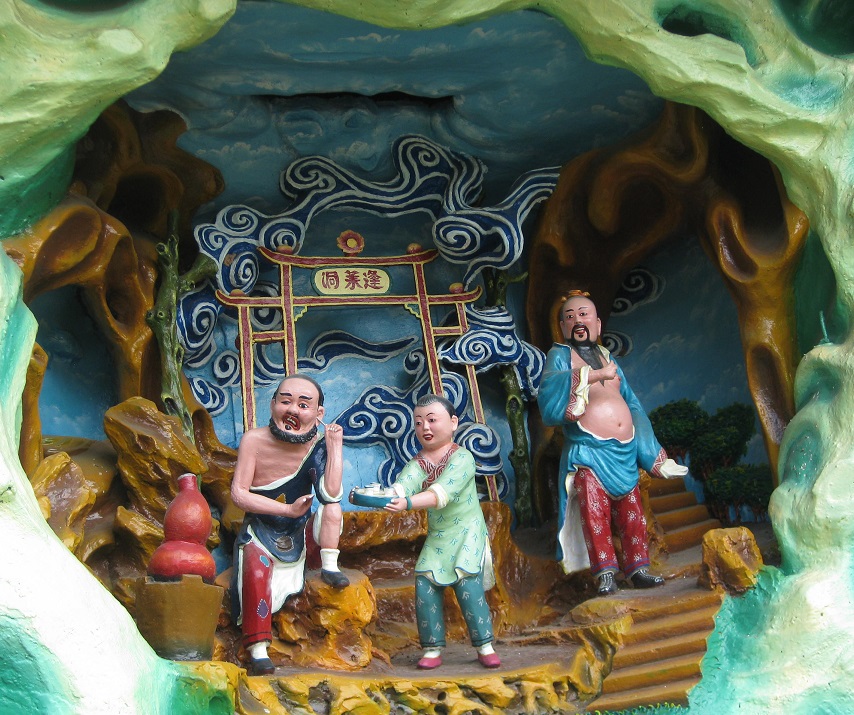 I don’t know why Wikipedia calls this a theme park, since there are no rides. (B says that it is technically a park with a theme. [More like 50,000 themes. -B]) It’s more like a garden with life-size figurines and dioramas, reflecting Chinese folk stories and culture. They range from the size of my hand to fifteen of me put together, and the vast difference in their styles made me wonder how many artists worked on them. There are figures from general Chinese culture, like Confucius and the gods of prosperity, blessings, and longevity. Then, there are specific parables to show why loyalty or frugality are good things. Some of them are a bit controversial, like the woman breastfeeding her mother-in-law because she didn’t have the teeth necessary to eat solids. And then there’s Hell, a section of the park dedicated to showing what happens to those who commit grave misdeeds. The good news is that after the tortures, you are given amnesia tea to drink and reincarnated to try again; the bad news is that before that, you suffer anything from ‘being drowned in a pool of blood’ or ‘having your heart cut out’ to ‘being thrown onto a hill of knives’ or ‘being crushed under boulders.’ As you can see, the founders of this park were quite serious about discouraging immorality. Speaking of that, the park was thought up and created by one of the brothers who started Tiger Balm cream – for the other one. M, if you feel compelled to get me something, I like massages more than morality. Filial gifts aside, I would recommend coming here. It’s fun to try to decipher the stories and to enjoy the art; there’s also plenty of shade, and it’s free!
I don’t know why Wikipedia calls this a theme park, since there are no rides. (B says that it is technically a park with a theme. [More like 50,000 themes. -B]) It’s more like a garden with life-size figurines and dioramas, reflecting Chinese folk stories and culture. They range from the size of my hand to fifteen of me put together, and the vast difference in their styles made me wonder how many artists worked on them. There are figures from general Chinese culture, like Confucius and the gods of prosperity, blessings, and longevity. Then, there are specific parables to show why loyalty or frugality are good things. Some of them are a bit controversial, like the woman breastfeeding her mother-in-law because she didn’t have the teeth necessary to eat solids. And then there’s Hell, a section of the park dedicated to showing what happens to those who commit grave misdeeds. The good news is that after the tortures, you are given amnesia tea to drink and reincarnated to try again; the bad news is that before that, you suffer anything from ‘being drowned in a pool of blood’ or ‘having your heart cut out’ to ‘being thrown onto a hill of knives’ or ‘being crushed under boulders.’ As you can see, the founders of this park were quite serious about discouraging immorality. Speaking of that, the park was thought up and created by one of the brothers who started Tiger Balm cream – for the other one. M, if you feel compelled to get me something, I like massages more than morality. Filial gifts aside, I would recommend coming here. It’s fun to try to decipher the stories and to enjoy the art; there’s also plenty of shade, and it’s free! - Wholesale Centre: You won’t find this on any tourist lists, and it wasn’t on ours either. However, the chef at the Russian restaurant we visited offered to take us on a free guided tour, so we would know where to purchase our fresh groceries. If you’re buying in bulk, the prices here are close to unbeatable; at quantities for one family, prices are closer to regular grocery stores. However, it’s an unusual and interesting place to walk through during the day. There are vendors of every kind of produce or meat you can possibly imagine. The wares aren’t in fancy displays, but you can ask for anything you don’t see. We bought mangos, avocados, and eggs, but the selection seemed infinite. Two things to be aware of: (1) There are produce, meat, and seafood juices on the ground, so you may want to wear galoshes, and (2) The smells aren’t always appetizing. I wouldn’t go out of your way to come here, but if you’re visiting Haw Par Villa, this could be fun to do – and there’s a hawker centre there too, if you’re hungry.
- Botanic Gardens,
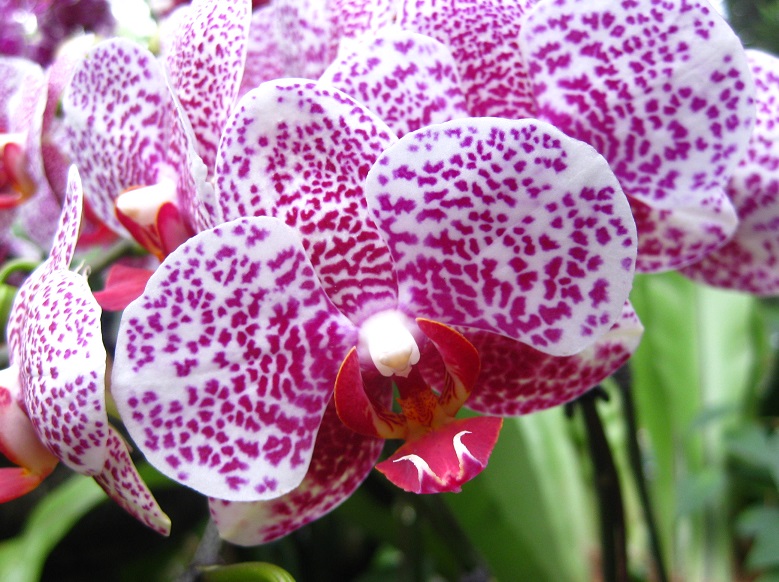 including Orchid Garden: Walking through these gardens was a peaceful way to spend the day. Around the park are statues, a lake with black swans, and several flower patches. They also have a Medicinal Garden, which mostly made me realize that the plants used to treat health conditions tend to be nondescript. The Ginger Garden and tropical tree path were nice too, though the piece de resistance of is the Orchid Garden there. They ‘create’ orchids by splicing together different plants’ DNA, designing a new breed of a specific color or shape. Then, they name these creations after world leaders who visit, thereby using the garden as a tool of diplomacy. The garden also includes a few carnivorous plants and some pretty arches and sculptures. Recommended!
including Orchid Garden: Walking through these gardens was a peaceful way to spend the day. Around the park are statues, a lake with black swans, and several flower patches. They also have a Medicinal Garden, which mostly made me realize that the plants used to treat health conditions tend to be nondescript. The Ginger Garden and tropical tree path were nice too, though the piece de resistance of is the Orchid Garden there. They ‘create’ orchids by splicing together different plants’ DNA, designing a new breed of a specific color or shape. Then, they name these creations after world leaders who visit, thereby using the garden as a tool of diplomacy. The garden also includes a few carnivorous plants and some pretty arches and sculptures. Recommended! - Gardens by the Bay:
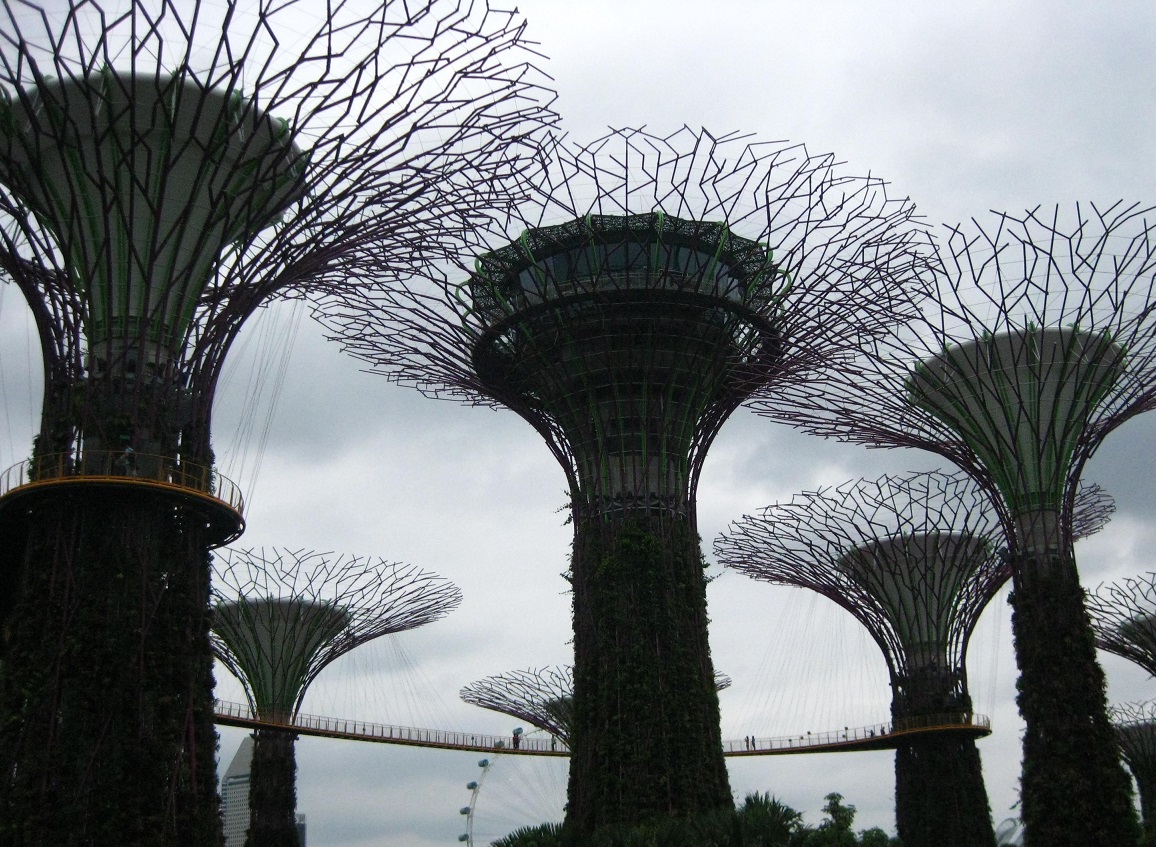 We probably should have gone inside the bio-domes here, but it was very expensive. (Smartly, the gift shop’s books showing what was inside were sealed; most other places are not that clever.) We didn’t feel too bad because we got to walk through the Gardens around the Domes, which were interesting enough – though not as cool as the Botanical Garden, in my opinion. In those gardens, there were multiple fish tanks with species explanations, lots of sculptures of lions, and a giant baby sculpture supported only by its hand. The most well-known part of this thing though are its Supertrees. These are a bunch of huge metallic structures kind of resembling trees, clustered together. One has a restaurant inside, but there’s nothing else inside them (despite my continued attempts to find something). The main two attractions are (1) seeing the Trees light up on the outside at night or (2) going up onto the skybridge strung between a few of the Trees. I was still motion sick this day, so sadly didn’t go up, but it looked like a nice experience, especially if you’re moderately (but not deathly) afraid of heights.
We probably should have gone inside the bio-domes here, but it was very expensive. (Smartly, the gift shop’s books showing what was inside were sealed; most other places are not that clever.) We didn’t feel too bad because we got to walk through the Gardens around the Domes, which were interesting enough – though not as cool as the Botanical Garden, in my opinion. In those gardens, there were multiple fish tanks with species explanations, lots of sculptures of lions, and a giant baby sculpture supported only by its hand. The most well-known part of this thing though are its Supertrees. These are a bunch of huge metallic structures kind of resembling trees, clustered together. One has a restaurant inside, but there’s nothing else inside them (despite my continued attempts to find something). The main two attractions are (1) seeing the Trees light up on the outside at night or (2) going up onto the skybridge strung between a few of the Trees. I was still motion sick this day, so sadly didn’t go up, but it looked like a nice experience, especially if you’re moderately (but not deathly) afraid of heights. - Singapore Art Museum: We both independently found this to be one of the most interesting modern art museums we have ever visited. There was a multitude of unique exhibits, described here. Heartily recommended!
- Peranakan Museum: It took me too long to understand what group of people ‘Peranakan’ refers to, especially since it translates simply to ‘child.’ It turns out that it was the children born of Chinese merchants who settled in the area, marrying local Malay women, many centuries ago. They were the original ‘mixed’ generation, and their kids (many generations removed) call themselves ‘Peranakan.’ Nowadays, there are many more mixed race folks in Singapore, but the term doesn’t seem to apply to these parvenues. What’s interesting is that this museum focused on the Chinese customs that these families retained, but our host here considered it a Malay museum. The photo exhibit showing Peranakan people showed the majority of them having some Chinese ancestry, but not exclusively so: there was at least one woman of Indian and Malay mixed ancestry. The rest of the exhibits covered Peranakan traditions, from weddings and funerals to furniture and religious practice. We both thought it was well done: everything from the mannequins arranged and dressed like a Peranakan wedding procession to the Peranakan bedroom model brought the culture to life. Recommended, though not above some of the other items listed here.
- Esplanade Arts Center:
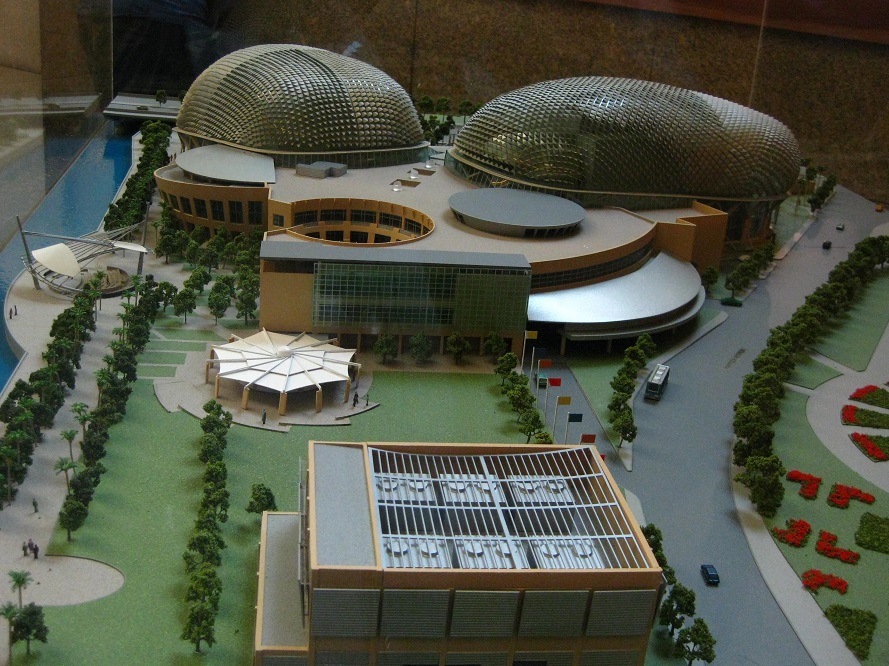 This is Singapore’s primary arts center, and it took an inordinately large amount of money and time to build. The building is pretty nice, with many levels and a rooftop terrace with a great view of Marina Bay, the Merlion, and much more. There are also a host of expensive shops, various cafes, a kids play area, several big art works, and a modernized library. They also have an art gallery that we enjoyed, with an exhibit focused on spirituality. Consistent with our experience at the Singapore Art Museum, we found several of the pieces to be thought-provoking, despite being modern works. The funniest one was the taxidermy piece, which spent more time explaining that the animals were scavenged after death than it did explaining the work itself. (Lots of animal activists locally, perhaps?) However, the main thing here are the numerous artistic performances the venue holds. There was an outdoor amphitheater hosting music performances, an indoor stage with love songs performed in honor of Valentine’s Day, an interactive children’s performance in a theatre next to the art gallery, and many more, all free.
This is Singapore’s primary arts center, and it took an inordinately large amount of money and time to build. The building is pretty nice, with many levels and a rooftop terrace with a great view of Marina Bay, the Merlion, and much more. There are also a host of expensive shops, various cafes, a kids play area, several big art works, and a modernized library. They also have an art gallery that we enjoyed, with an exhibit focused on spirituality. Consistent with our experience at the Singapore Art Museum, we found several of the pieces to be thought-provoking, despite being modern works. The funniest one was the taxidermy piece, which spent more time explaining that the animals were scavenged after death than it did explaining the work itself. (Lots of animal activists locally, perhaps?) However, the main thing here are the numerous artistic performances the venue holds. There was an outdoor amphitheater hosting music performances, an indoor stage with love songs performed in honor of Valentine’s Day, an interactive children’s performance in a theatre next to the art gallery, and many more, all free. - Clarke Quay (pronounced ‘Key’):
 If you’re under the age of 26, this is likely the first place you learned about in Singapore. It’s a party area, with lots of fancy food and a big club scene. Its location along a river adds to the appeal, as do the hot pink structures and fountains in the complex. They even have a bungee bounce thing that people can ride in! But, here’s the thing: you’ll spend all of your money here. I mean, we skipped the sushi, Spanish food, and fresh seafood, and just looked at prices for hot dogs – and they were $9 each! This is a plain hot dog without any fancy toppings or drinks included. I’m sorry, but I see no reason to hemorrhage money for the opportunity to see and be seen, though I can see why you might want to. B liked sitting on the steps on the other side of the river, though the whole area turned me off.
If you’re under the age of 26, this is likely the first place you learned about in Singapore. It’s a party area, with lots of fancy food and a big club scene. Its location along a river adds to the appeal, as do the hot pink structures and fountains in the complex. They even have a bungee bounce thing that people can ride in! But, here’s the thing: you’ll spend all of your money here. I mean, we skipped the sushi, Spanish food, and fresh seafood, and just looked at prices for hot dogs – and they were $9 each! This is a plain hot dog without any fancy toppings or drinks included. I’m sorry, but I see no reason to hemorrhage money for the opportunity to see and be seen, though I can see why you might want to. B liked sitting on the steps on the other side of the river, though the whole area turned me off. - Exploring Neighborhoods: Getting to know a city by walking through its neighborhoods is one of my favorite things to do! In addition to the big neighborhoods below, we also visited a range of local neighborhoods, like Holland Village and Kent Road/University. A lot of them have cafes and shops right near the metro stations for the neighborhoods, so you can run errands there. It gave us a great sense of Singapore, but I’m not sure there’s a specific one I’d recommend.

- Downtown/CBD (Central Business District): Postcards or videos of Singapore tend to show this area, full of towering glass skyscrapers. Many of them are banks, making it similar to Midtown in NYC. However, even here, there are interesting things to be seen. For example, there are tons of interesting sculptures in this area, including ones by artists as famous as Dali or Moore. I also liked the Guinness Record-setting vertical garden on the side of a building: not only was it made to be a map of the world, but it also offset carbon emissions from the parking garage located inside the building! In the very center, there were even a few porch swings – presumably so you can watch the giant video screen there. A few of the bank buildings even had art galleries or other interesting things inside, so you may want to explore here.
- Kampong Glam (Arab Quarter):
 Lonely Planet claims that locals would be confused if you asked about the Arab Quarter, since they all call it Kampong Glam. However you refer to it, this was a nice area to visit. Though we couldn’t go inside the Sultan Mosque, it’s the most important national landmark (since 1975) in the area. During warfare in the 40s, the sign out front claimed, “people of different ethnicities and creeds sought shelter at the mosque, and one of its minarets served as an observation post to look out for enemy aircraft.” There is a pedestrian street at the front of the Mosque on which you can find overpriced food, but underpriced souvenirs! If you walk a bit farther, the restaurant prices get a bit more reasonable, and you can see the variety here – from Moroccan or Turkish to Saudi or Kuwaiti. It was cool to see!
Lonely Planet claims that locals would be confused if you asked about the Arab Quarter, since they all call it Kampong Glam. However you refer to it, this was a nice area to visit. Though we couldn’t go inside the Sultan Mosque, it’s the most important national landmark (since 1975) in the area. During warfare in the 40s, the sign out front claimed, “people of different ethnicities and creeds sought shelter at the mosque, and one of its minarets served as an observation post to look out for enemy aircraft.” There is a pedestrian street at the front of the Mosque on which you can find overpriced food, but underpriced souvenirs! If you walk a bit farther, the restaurant prices get a bit more reasonable, and you can see the variety here – from Moroccan or Turkish to Saudi or Kuwaiti. It was cool to see! - Chinatown: If you’ve been to Chinatown in New York, it’s a little like that, except better-smelling.
 There’s also more tourism-oriented things here, from the famous ‘Food Street’ to the expensive-for-the-neighborhood stands selling silk robes, red lanterns, or dried fruit. Make sure to venture beyond the big mass of shops right by the subway station: there are cheaper and more authentic shops just a bit farther away. I liked going to a Chinese herbal medicine shop, though it didn’t seem any different here than it did at the West Coast Market Centre. They have lots of something that looks like a dried, dirty grey snake, which I’ve seen in San Francisco’s Chinatown too. I bought some medicines there that I have yet to try. I didn’t get to go to any local tea ceremonies, though I hear that’s a relic of a bygone era. I did visit the Sri Mariamman Temple and the Buddha Tooth Relic Temple, both active places of worship. The former had large, colorful sculptures that looked Hindu to me, while the latter houses what some believe to be a tooth of one of the most-beloved Buddhas. (The former turned out to be Singapore’s oldest Hindu temple.) Rites were going on at both temples when we visited, but it was Chinese New Year for the second visit, so we got to see people celebrating! The Thian Hock Keng Temple was closed when we went, but was one of the first in the area. I would come to Chinatown for the food alone, but seeing these other landmarks is worthwhile too. In general, I preferred the outlying areas of Chinatown with fewer tourists, though the center is exciting.
There’s also more tourism-oriented things here, from the famous ‘Food Street’ to the expensive-for-the-neighborhood stands selling silk robes, red lanterns, or dried fruit. Make sure to venture beyond the big mass of shops right by the subway station: there are cheaper and more authentic shops just a bit farther away. I liked going to a Chinese herbal medicine shop, though it didn’t seem any different here than it did at the West Coast Market Centre. They have lots of something that looks like a dried, dirty grey snake, which I’ve seen in San Francisco’s Chinatown too. I bought some medicines there that I have yet to try. I didn’t get to go to any local tea ceremonies, though I hear that’s a relic of a bygone era. I did visit the Sri Mariamman Temple and the Buddha Tooth Relic Temple, both active places of worship. The former had large, colorful sculptures that looked Hindu to me, while the latter houses what some believe to be a tooth of one of the most-beloved Buddhas. (The former turned out to be Singapore’s oldest Hindu temple.) Rites were going on at both temples when we visited, but it was Chinese New Year for the second visit, so we got to see people celebrating! The Thian Hock Keng Temple was closed when we went, but was one of the first in the area. I would come to Chinatown for the food alone, but seeing these other landmarks is worthwhile too. In general, I preferred the outlying areas of Chinatown with fewer tourists, though the center is exciting. - Little India:
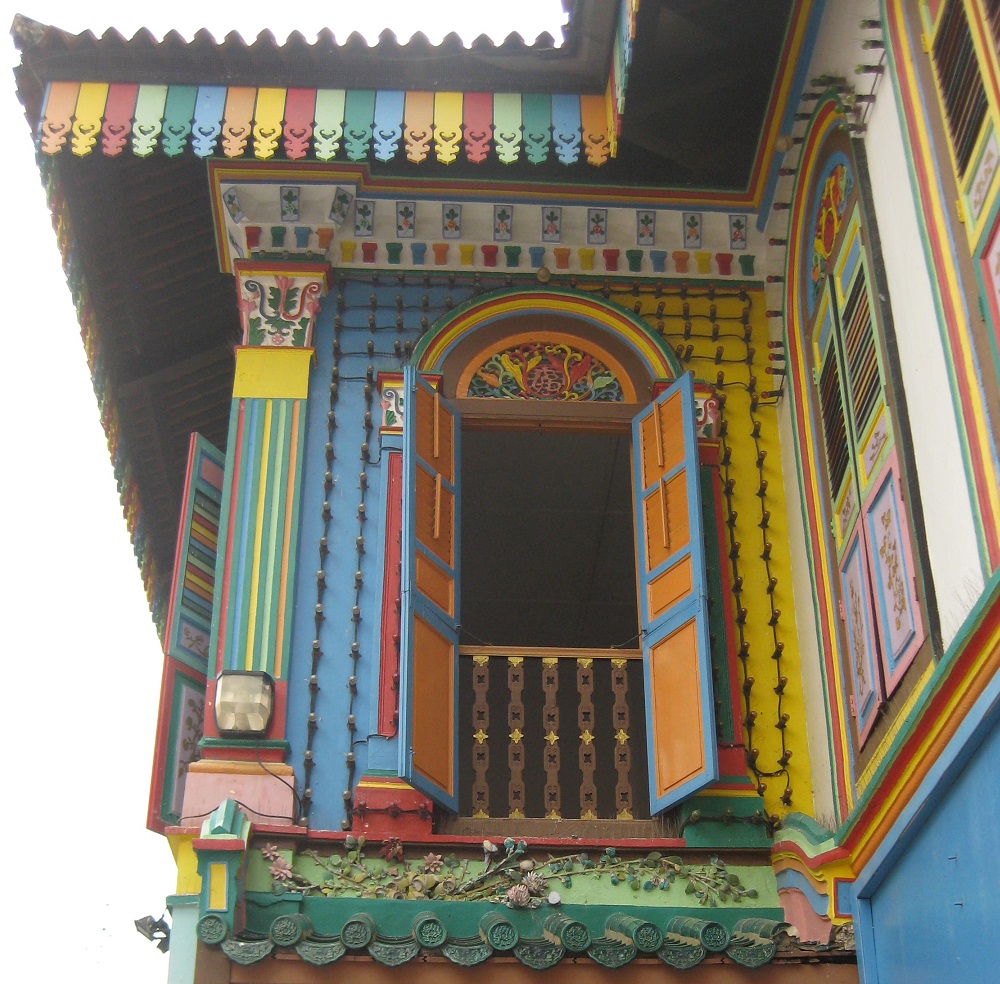 We came here on a Sunday, which is the day to come here, because many Indian laborers have Sunday as their only day off. The neighborhood fills up with people, and you can see what the locals do day-to-day: eat, shop at big flea markets, stand in line for the ATM or for mobile phone stands, and stand around chatting with friends. There are some pretty buildings here, painted in bright colors. I also enjoyed our visit to the Sri Veeramakaliamman Temple. We missed Thaipusam, a Hindu Tamil festival for which people attach heavy weights and portable shrines to their skin and carry them across the city to another shrine. However, rites were going on anyway, and that was nice to watch too: fruit and such was being given to various Hindu gods, and men wearing only sheet-like makeshift skirts were acting as priests. We went to a less touristy, local temple too, where kids were playing around and adults were paying temple dues: just everyday life. I would definitely recommend this area!
We came here on a Sunday, which is the day to come here, because many Indian laborers have Sunday as their only day off. The neighborhood fills up with people, and you can see what the locals do day-to-day: eat, shop at big flea markets, stand in line for the ATM or for mobile phone stands, and stand around chatting with friends. There are some pretty buildings here, painted in bright colors. I also enjoyed our visit to the Sri Veeramakaliamman Temple. We missed Thaipusam, a Hindu Tamil festival for which people attach heavy weights and portable shrines to their skin and carry them across the city to another shrine. However, rites were going on anyway, and that was nice to watch too: fruit and such was being given to various Hindu gods, and men wearing only sheet-like makeshift skirts were acting as priests. We went to a less touristy, local temple too, where kids were playing around and adults were paying temple dues: just everyday life. I would definitely recommend this area! - Geylang: This neighborhood is known for being Singapore’s red light district, but it seems to have been notably cleaned up. I saw a few strip clubs and karaoke places the night we went, but the majority of people we saw were couples eating dinner. It seems like the area’s rent probably went down based on its reputation, so lower income young families moved in.
- Orchard Road: This is a very popular shopping area, like Rodeo Drive plus the 3rd Street Promenade (in LA) on drugs. There are dozens of mall buildings with stores ranging from super expensive to relatively cheap. Many have food courts with local chain restaurants, everything is impeccably clean, and they even have sculptures to class it up further. Worth visiting, but I personally wouldn’t shop here.
- Marina Bay Sands:
 This is a giant hotel, casino and mall – like a mini Vegas. The casino’s security was quite strict, so be sure to bring your passport if you want to go inside. The mall had shallow water at the bottom level, so that boats can transport lazy shoppers from one end to the other. I have to believe that this is a publicity stunt, because half the malls I have visited in my life have been bigger than this one was. The shops varied from Gucci and a tea room called ‘High Society’ to a Bath and Body Works and the equivalent of a CVS. The attached hotel has a ton of rooms, with at least some of the visitors staying there because the roof has an infinity pool; that’s the kind where it looks like you’re falling off the edge of the world. Given that this seems to be one of the tallest buildings in town, this is no small matter. I personally thought that the building was very interesting from afar: it looks like it has a boat sitting on top of it! Up close, it just reminded me of parts of the US that I dislike. There was also a Da Vinci exhibit going on, though I’m not sure where.
This is a giant hotel, casino and mall – like a mini Vegas. The casino’s security was quite strict, so be sure to bring your passport if you want to go inside. The mall had shallow water at the bottom level, so that boats can transport lazy shoppers from one end to the other. I have to believe that this is a publicity stunt, because half the malls I have visited in my life have been bigger than this one was. The shops varied from Gucci and a tea room called ‘High Society’ to a Bath and Body Works and the equivalent of a CVS. The attached hotel has a ton of rooms, with at least some of the visitors staying there because the roof has an infinity pool; that’s the kind where it looks like you’re falling off the edge of the world. Given that this seems to be one of the tallest buildings in town, this is no small matter. I personally thought that the building was very interesting from afar: it looks like it has a boat sitting on top of it! Up close, it just reminded me of parts of the US that I dislike. There was also a Da Vinci exhibit going on, though I’m not sure where. - Merlion: This is a giant lion statue, and Singapore’s mascot. There’s one in the downtown (CBD) area and one on Sentosa Island and a whole host of little ones about town. The one on Sentosa is bigger, has a mouth that lights up at night, and somehow costs money – presumably to go to the top. The one downtown spouts water out of its mouth and is more crowded.
- Sentosa Island: We walked over to this amusement park island to see what this tourist haven was all about. As I’m sure you could guess from my curmudgeonly ways, this kind of place isn’t my favorite. However, the waterpark was worthwhile, and the rest was decent enough. Eat on Malaysia Food Street, the most affordable food on the island, as B discovered.
- Adventure Cove Waterpark: If you have kids, this is a must. And if you don’t, you can still enjoy yourself, especially if you don’t get motion-sick on water slides.
- Luge and Skyride: This is a bit like go kart racing, except that the cars move using gravity alone—you can only steer and brake. The track seemed a bit short to me, and I somehow managed to get stuck at the end. The skyride back was especially nice at night.
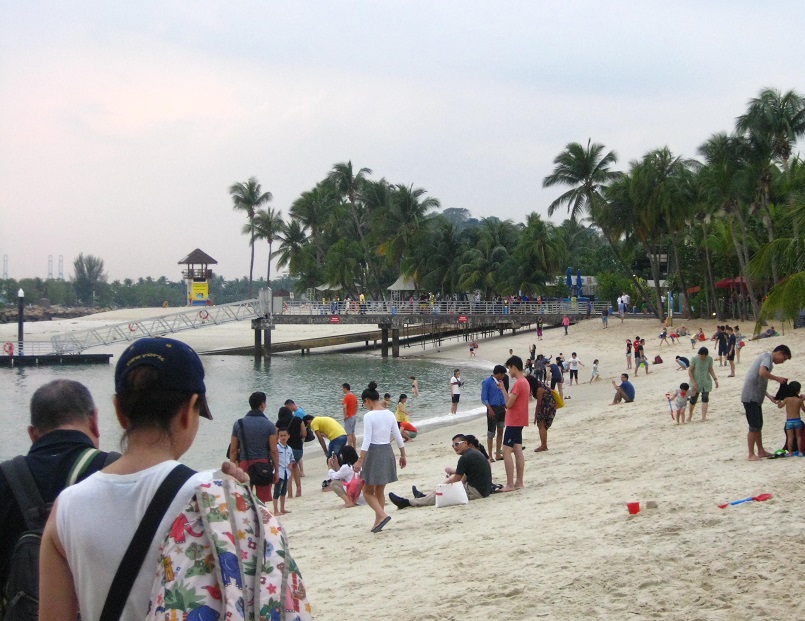 Wings of Time show: You don’t need to pay the $18 for this. Because it’s a lights, water, and fireworks show, it’s visible to all from Siloso Beach on Sentosa. For the record, we didn’t set out to shirk the fee: we just happened to be on the beach when the festivities began.
Wings of Time show: You don’t need to pay the $18 for this. Because it’s a lights, water, and fireworks show, it’s visible to all from Siloso Beach on Sentosa. For the record, we didn’t set out to shirk the fee: we just happened to be on the beach when the festivities began.- Siloso Beach: While the beaches on this island are nothing compared to others in Southeast Asia, they’re nice enough. There are places to chill or to have a snack, especially if you don’t mind overpaying and like listening to 90s music. They know their demographic!
- Just a note that some of the items listed on the Sentosa site are not really things. For example, the ‘Lake of Dreams’ is a fountain with a few sculptures inside. So, unless I misunderstand ‘lake’ or ‘dreams,’ somewhat false advertising.
What We Skipped:
It looks like we missed a lot, but we purposely skipped many of these.
- Museum of Shanghai Toys: This seemed like a fun idea, but it was too crowded and crazy in Little India on the day we went (a Sunday) to get here. Maybe next time!
- Hua Song Museum: This museum was supposed to be on the grounds of Haw Par Villa, but we didn’t notice it. There were signs about some exhibits that had passed, so perhaps it was closed until the next exhibition? Or perhaps we just weren’t paying enough attention.
- Changi Prison Museum: We visited this far part of town to meet our friends, but there wasn’t enough time to find the museum. Unfortunately, I am not sorry because stories of people subjugating other people is not my cup of tea – and I hear the Japanese weren’t so nice to the locals during WWII.
- National Museum: After reading this museum’s list of their top ten treasures, we were not inspired to visit. However, we did enter the building so I could photograph the dome, which had some stained glass. Not worth going out of your way, though there are some cool sculptures in the gardens, if you are so inclined.
- Singapore Flyer:
 Another city, another expensive ferris wheel. No, thank you.
Another city, another expensive ferris wheel. No, thank you. - Forbidden Hill/Fort Canning Park: We had no good reason for skipping this park, which is supposed to be quite cool on a hot day. The ‘Forbidden’ part is because it was once thought to house evil spirits or some such. Some bigwig’s house also used to be up there, during colonial days.
- Chinatown Heritage Center Museum: This is closed for renovation until later in 2015. It might be cool?
- Turtle and Tortoise Museum: We just didn’t make this a priority. Sorry, turtle-oises!
- Chinese/Jurong Garden: We didn’t make it here either. It’s where the turtles are.
- Istana: I thought that this was just a cool park, so we trekked over, but when we got to the front, the line to get in was ridiculous. B estimated that it would take six hours to get to the front, all in the direct sunlight. It turns out that this is actually the President’s House and grounds, which is only open to the public on holidays like Chinese New Year. So, we opted out of standing in line for the rest of the day and looked at photos online. If you come when this is actually open, prepare for a long wait – and bring snacks. Also, there are scary no trespassing signs around the perimeter of these grounds, in which a figure is pointing a bayonet at a person with his hands up in surrender. Don’t jump the fence.
- Hike Bukit Timah or MacRitchie Nature Reserve: We chose to walk around the city’s gardens and neighborhoods instead.
- Pulau Ubin: This is one of last remaining ‘kampongs’ (villages, in Malay), but it’s more ghost town than village. It’s pretty far from anything, so we opted out.
- River Safari or Night Safari: We skipped both of these because they were super expensive, and because I don’t consider them better (from an animal rights perspective) than zoos, and because it’s just not my thing. But a mom we met in Cambodia recommended them, as did her kids, so it’s probably a good place to check out.
- Watch a tchoukball match: We didn’t try hard enough to do this; it seems like it would have been fun.
- On Sentosa Island:
- 4D Show: This Sentosa attraction was being advertised with a picture of the Rock crawling through foliage. As we said in the 90s, ‘nuff said.
- Butterfly Park: A local we met told us that they don’t take proper care of these butterflies, releasing their predators into the same environment – and thereby decimating the population. We didn’t visit.
- Cable Car: We only missed this because I got too motion sick in the rest of the park. But it seemed quite fun and relatively affordable, especially if you do the nighttime deal: S$39 (30 USD) for a couple, which also includes drinks and snacks!
- Fort Siloso: This old fort museum on Sentosa (amusement park) Island just didn’t seem that exciting from the photos and descriptions. Perhaps we’re wrong though?
- Images of Singapore Live: The history covered here was limited, according to their website, so we opted out.
- Madame Tussaud’s: I’ve never understood the appeal of not-quite-right celebrity wax molds, but I seem to be in the minority. I recall my grandmother’s shock that this was not high on my priority list in a city like London. Is it just me? What is the appeal here?
- SEA Aquarium: They say that this is the biggest aquarium in Asia, though we can neither confirm nor deny. We passed because of the fee, but also because you can see lots of cool fish, dolphins, and rays at the waterpark, which is generally more fun.
- Tiger Sky Tower: I got motion sick just watching this quickly-rotating observation deck from below, so there was nothing that would have gotten me onto it.
- Trapeze and Megazip: These were both fairly expensive, and we had limited time, so we decided to skip them. If you’ve never done them before though, it may be worth it; it’s still less expensive than in the US.
- Trick Eye Museum: This is an export from Seoul that consists of various backdrops that make it look like you’re inside the settings. A little too hokey-looking, and at the price (normal for Sentosa Island), not worth it for us. It might be fun in a group that likes to take funny photos.
- Universal Studios: Maybe if we were ten years old, the $79+ price tag would seem worth it. As it is, we passed.



Pingback: Surprising Things About Singapore - Novelty Buffs
Love strolling thru gardens and parks. The most relaxing thing next to the ocean and giant redwoods.
Pingback: What We Saw in Osaka - Novelty Buffs